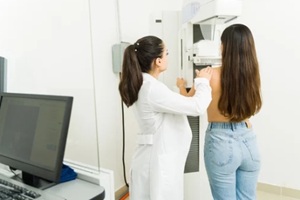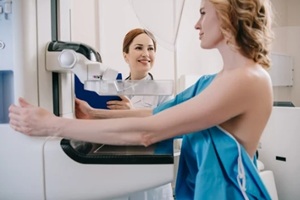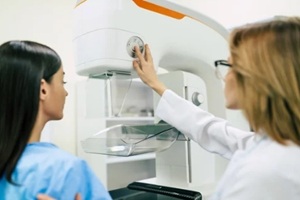 Breast cancer is one of the most significant public health concerns in the world. In the U.S. alone, an estimated 316,950 new cases of invasive breast cancer are expected to be diagnosed in women in 2025. Early detection continues to be a monumental factor in improving survival rates and reducing the severity of treatment needed. To catch breast cancer in its earliest stages, a range of screening tools are used, most commonly a mammogram and clinical breast exams (CBEs).
Breast cancer is one of the most significant public health concerns in the world. In the U.S. alone, an estimated 316,950 new cases of invasive breast cancer are expected to be diagnosed in women in 2025. Early detection continues to be a monumental factor in improving survival rates and reducing the severity of treatment needed. To catch breast cancer in its earliest stages, a range of screening tools are used, most commonly a mammogram and clinical breast exams (CBEs).
While the mammogram is regarded as the gold standard in early detection, the clinical breast exam remains a valuable part of any exhaustive screening approach. Let’s look at why CBEs still matter, especially when used alongside mammograms in an ongoing effort to detect breast cancer early.
The Role of Mammograms in Breast Cancer Screening
Mammograms are a type of X-ray imaging of the breast that is used to detect early breast cancer, typically before symptoms appear. They are considered the cornerstone of routine breast cancer screening and have been instrumental in reducing mortality rates through early detection.
During a mammogram, the breasts are compressed between plates while a low-dose X-ray captures images from different angles. These images allow radiologists to identify abnormal areas that may indicate cancer, such as masses or macrocalcifications.
Benefits of mammography include:
- Early Detection – Mammograms can identify tumors that are too tiny to be physically felt during an exam, allowing for intervention at an earlier and more treatable stage.
- Improved Outcomes – Regular mammogram screenings yield a mortality reduction of 40 percent in women ages 40 to 84 compared to no screening.
- Long-Term Monitoring – Mammograms provide a baseline that can be used to track ongoing changes in breast tissue.
Despite their benefits, mammograms are not infallible. False positives are possible, resulting in unneeded stress and extra tests. False negatives can also occur, especially in women with dense breast tissue, as these abnormalities can be more difficult to detect.
Mammograms also do not replace the need for a physical assessment, especially when patients present with symptoms such as lumps or changes in breast appearance.
Clinical Breast Exams and Why They Matter
While mammograms are a powerful tool in breast cancer detection, they are not the only method that should be relied upon. Clinical breast exams are hands-on examinations of the breasts performed by a health provider. These exams offer a valuable and complementary approach to detecting issues that mammograms might miss.
 A clinical breast exam involves a trained medical professional systematically checking the breasts and underarm area for lumps, irregularities, skin changes, or other signs of concern.
A clinical breast exam involves a trained medical professional systematically checking the breasts and underarm area for lumps, irregularities, skin changes, or other signs of concern.
It typically takes just a few minutes and is often done during an annual physical or gynecological visit. During the exam, the provider also assesses the size, shape, and texture of any abnormalities to determine whether further testing is needed.
There are several reasons why CBEs still matter:
1. Detection Beyond Imaging
Mammograms can sometimes miss cancers, especially in women with dense breast tissue. A clinical exam can catch palpable lumps or changes that may not yet be visible on imaging.
2. More Personalized Evaluation
Unlike imaging, which provides a snapshot, a CBE allows for real-time feedback and patient-provider dialogue. This can help uncover symptoms such as tenderness, nipple discharge, or recent changes that a machine cannot detect.
3. Improved Access in Underserved Areas
In regions with limited access to mammography, clinical breast exams may be the only practical screening tool available. While not a substitute for mammograms, CBEs can still lead to early detection and prompt referral for imaging when needed.
4. Early Identification of Non-Cancerous Conditions
Many benign breast conditions, such as cysts or infections, can cause concern or discomfort. Clinical exams help diagnose and manage these issues, providing reassurance or guiding treatment.
Complementary Roles of CBEs and Mammograms
Clinical breast exams and mammograms are most effective when used together as part of an extensive breast cancer screening strategy. While mammograms excel at detecting abnormalities that are not yet palpable, they can occasionally miss certain types of tumors, particularly in women with dense breast tissue.
This is where CBEs provide critical support, allowing trained professionals to detect lumps or changes that might not appear on imaging. Using both tools increases the chances of early detection, which is important for more effective treatment outcomes.
 For example, a woman might present with a lump that is felt during a CBE but not visible on a mammogram, prompting further evaluation, such as an ultrasound or biopsy. Conversely, a mammogram might reveal a suspicious area long before it’s detectable by touch.
For example, a woman might present with a lump that is felt during a CBE but not visible on a mammogram, prompting further evaluation, such as an ultrasound or biopsy. Conversely, a mammogram might reveal a suspicious area long before it’s detectable by touch.
Stay on Top of Your Breast Care with Help from Raleigh Gynecology and Wellness
Early detection saves lives, and combining clinical breast exams with mammograms offers the most thorough approach to breast health. At Raleigh Gynecology and Wellness, we offer personalized and compassionate care so you can stay on top of your breast health. Contact us today to schedule your next clinical breast exam and mammogram to maintain your breast health.
